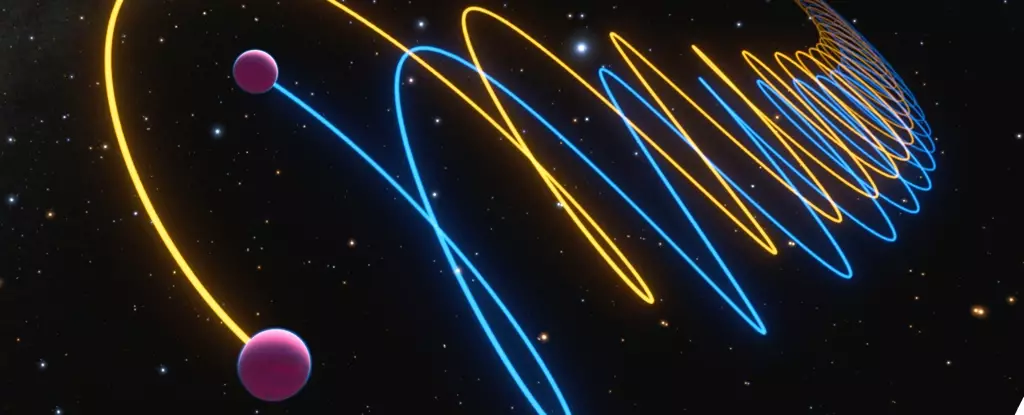In 1995, astronomers at Caltech’s Palomar Observatory made a groundbreaking observation: they detected what appeared to be a brown dwarf orbiting Gliese 229, a red dwarf star situated about 19 light-years away from Earth. This discovery marked a significant milestone in the ever-evolving field of astrophysics. Dubbed Gliese 229 B, this celestial body puzzled scientists since it was significantly dimmer than expected for an object with a mass estimated to be 70 times that of Jupiter. It presented a conundrum that would remain unsolved for nearly three decades, sparking curiosity and debate among astronomers worldwide.
Recently, researchers led by graduate student Jerry W. Xuan and professor Dimitri Mawet at Caltech have provided a remarkable clarification. The mystery of Gliese 229 B is not that it is a single brown dwarf, but rather a binary system composed of two closely orbiting brown dwarfs—partially resolving the long-standing questions regarding its luminosity.
The journey to understanding Gliese 229 B required an amalgamation of advanced technology and collaborative efforts from an international team of astronomers. Using the GRAVITY interferometer paired with the European Southern Observatory’s Very Large Telescope in Chile, they were able to spatially resolve the two brown dwarfs. The subsequent use of the CRyogenic high-Resolution InfraRed Echelle Spectrograph (CRIRES+) enabled the researchers to pinpoint their spectral signatures and gauge their Doppler shifts, ultimately confirming the existence of Gliese 229 Ba and Gliese 229 Bb—two distinct brown dwarfs each approximately 35 times more massive than Jupiter.
This joint effort not only helped unravel the enigma surrounding Gliese 229 B but also raised additional questions regarding the formation mechanisms of such binaries in the universe. The observations revealed that these brown dwarf companions orbit one another every 12 days and are separated by a distance equivalent to 16 times that between the Earth and the Moon. Their brightness levels align with theoretical predictions for small brown dwarfs, lending further credence to the resolution of their longstanding mystery.
Insight into Brown Dwarfs
The identification of Gliese 229 B as a binary system is profoundly significant for the study of brown dwarfs, a group of substellar objects that lie in the liminal space between gas giants and stars. Previously regarded as enigmatic entities, brown dwarfs are characterized by their inability to undergo hydrogen fusion like stars but possess more mass than traditional gas giants. The new findings reveal that the two brown dwarfs could be bound by their gravitational pull, a phenomenon that might occur within a star’s protoplanetary disk—a notion that adds a layer of depth to our understanding of formation processes among substellar objects.
Both research efforts that contributed to the revelation of Gliese 229 B included some of the same scientists who were involved in its initial discovery nearly 30 years earlier. The ongoing collaboration highlights the importance of scientific inquiry and how groundbreaking discoveries can spur new research avenues, effectively creating a ripple effect throughout the astronomical community. As Rebecca Oppenheimer, one of the discoverers, noted, the excitement was palpable when they first spotted an object smaller than a star orbiting another sun. Her sentiment reflects a broader enthusiasm for exploring the cosmos, which continues to inspire generations of scientists.
The significance of this discovery extends beyond just reclassifying Gliese 229 B. It opens the door for future investigations into the population of brown dwarfs and how they may exist in binary systems across the galaxy. The notion of a “poster-child” brown dwarf coupled with its newfound complexity will prompt astronomers to broaden their searches using cutting-edge instruments, such as the upcoming Keck Planet Imager and Characterizer (KPIC) and the Keck Observatory’s High-resolution Infrared Spectrograph for Exoplanet Characterization (HISPEC), both of which are being developed with the aim of identifying more binary systems in the cosmos.
As astronomers like Xuan and others pursue further inquiries into the unique attributes of brown dwarfs, they anticipate uncovering more binary pairs that could greatly enhance our comprehension of their evolutionary history and the dynamics governing their formation.
The revelation that Gliese 229 B consists of two brown dwarfs invites an exciting chapter in astrophysics and challenges previous assumptions about these intriguing classes of celestial objects. The dynamic interplay between them paints a vivid picture of the cosmos, illustrating the complexities of formation and structure beyond the known exoplanets and star systems. Ultimately, this discovery signifies a pivotal moment in our understanding of brown dwarfs, enhancing our engagement with the enigmatic universe that lies beyond our solar system. As we continue to unveil the mysteries of the cosmos, exciting new findings await, holding promises of discovery and enlightenment for generations to come.

